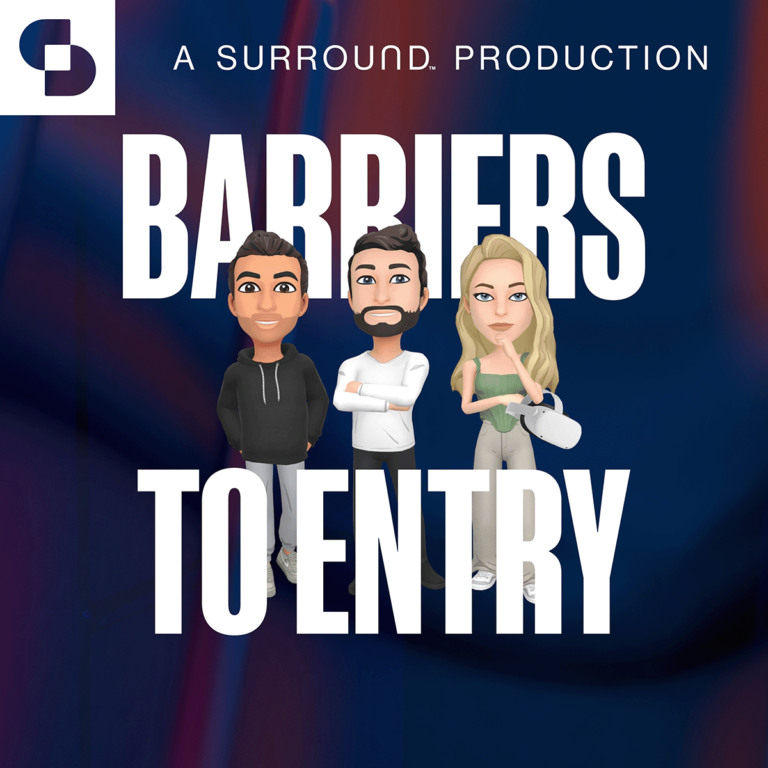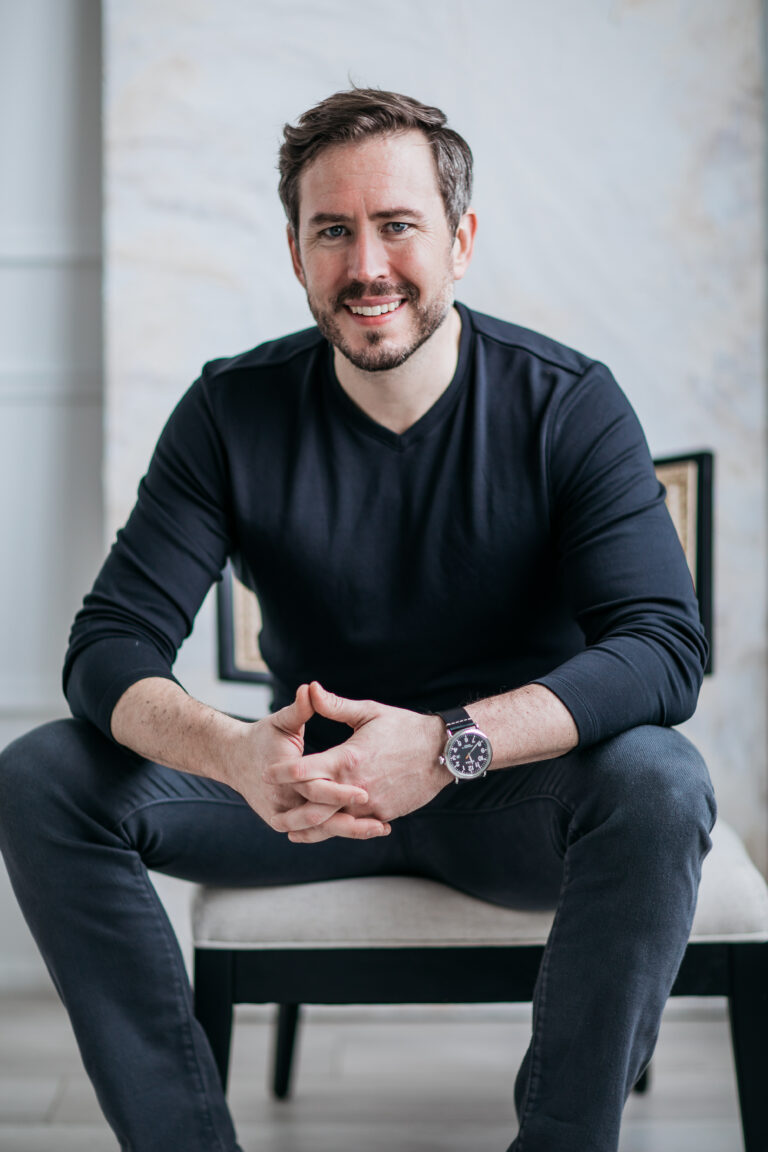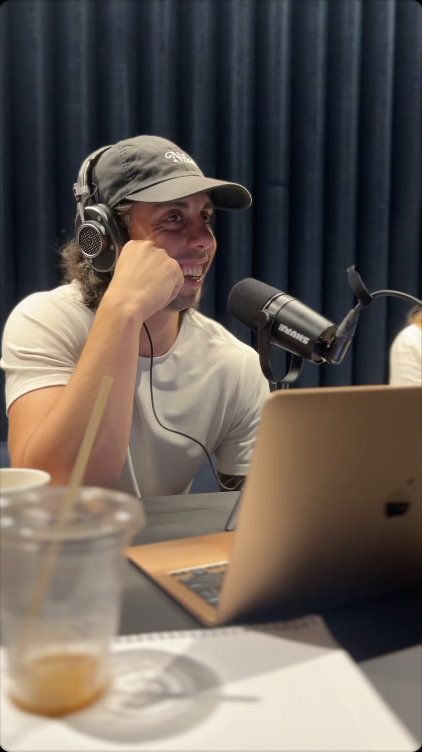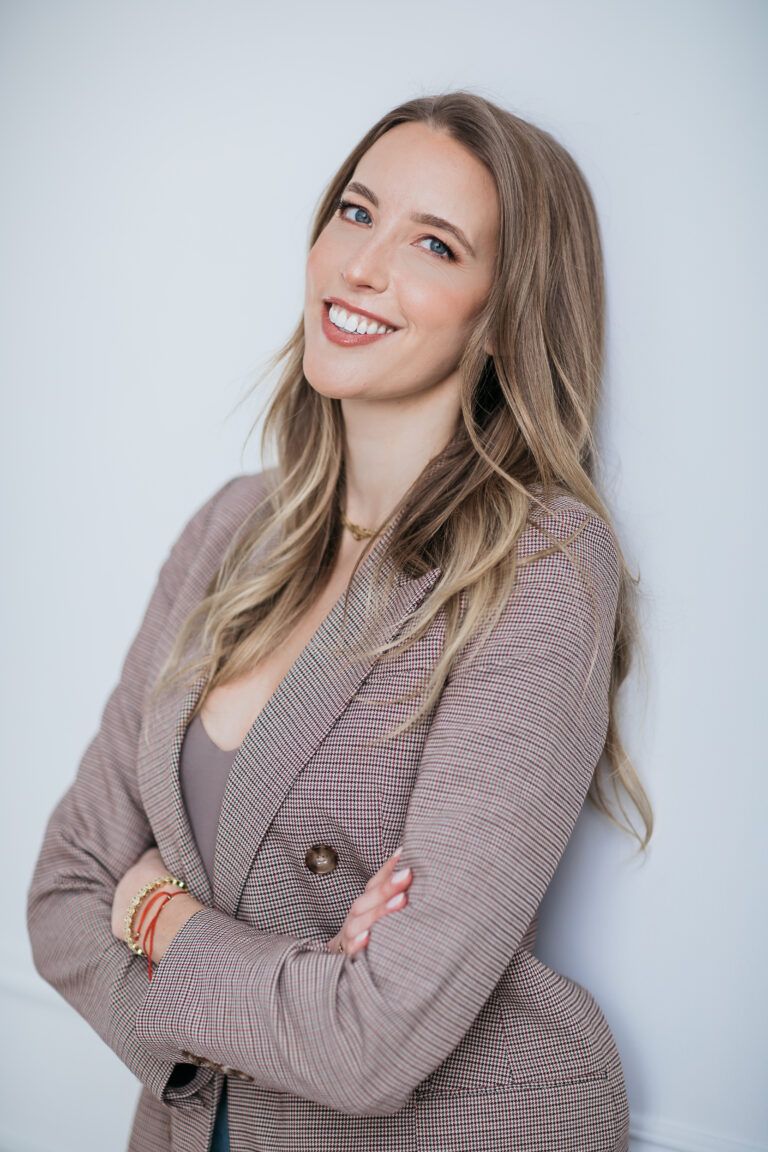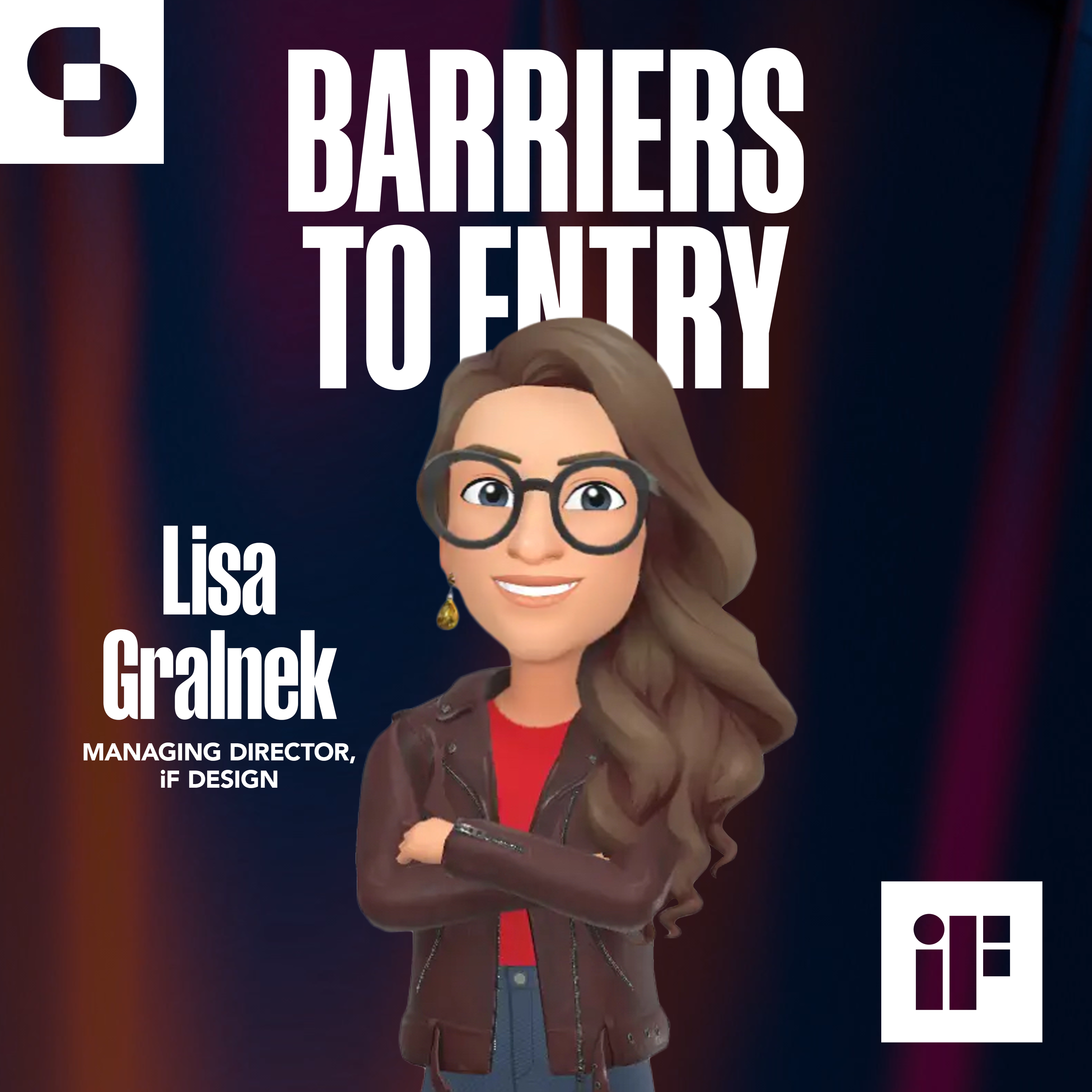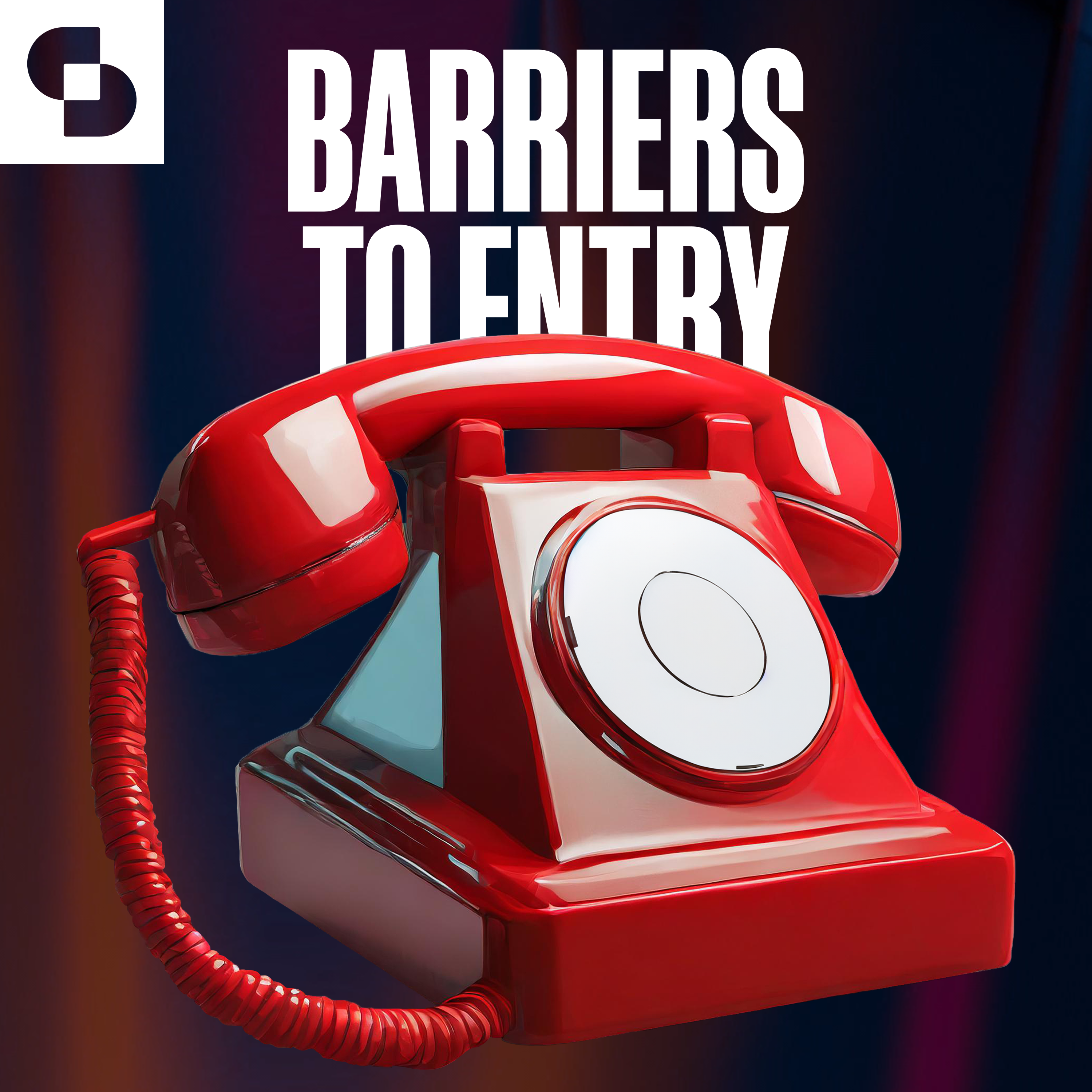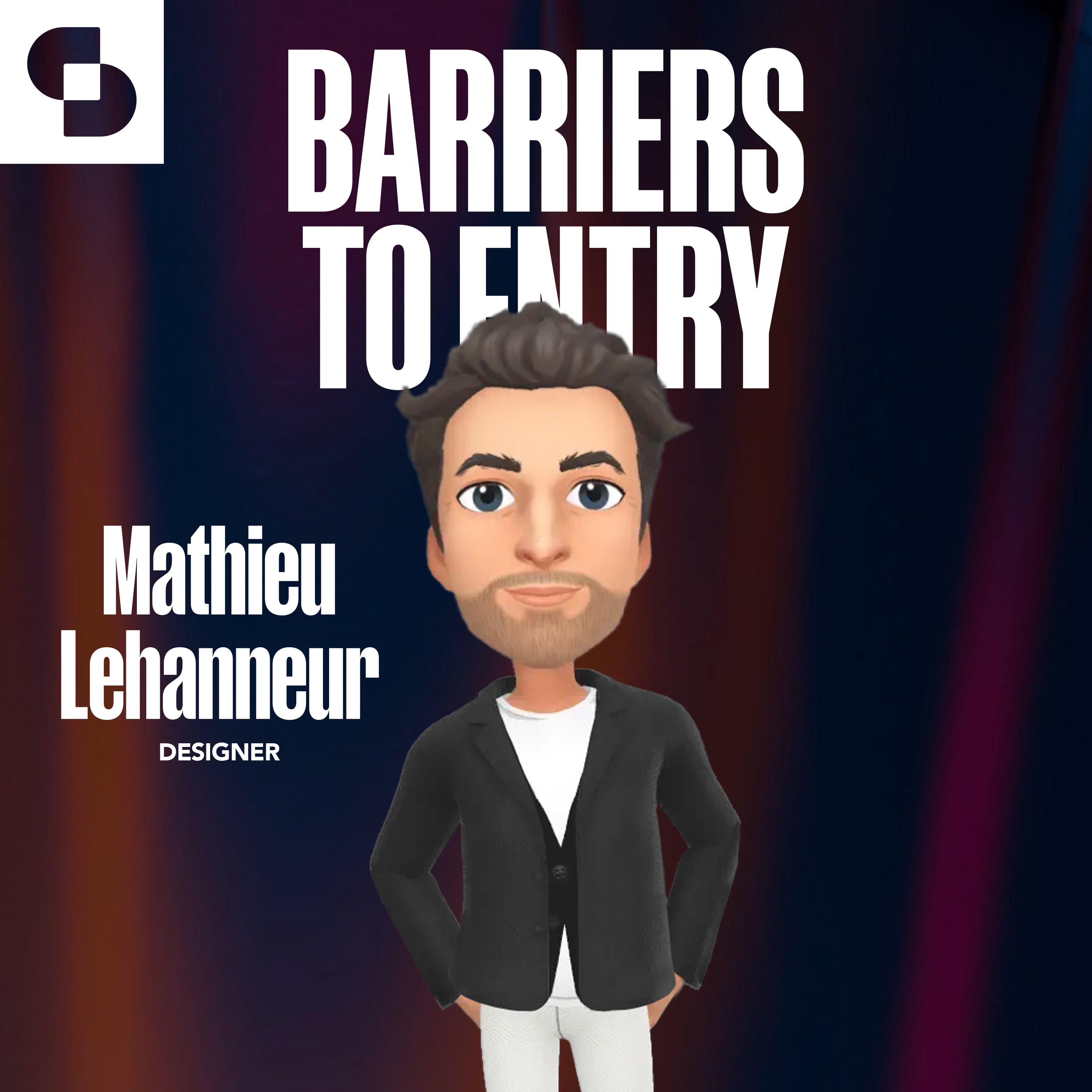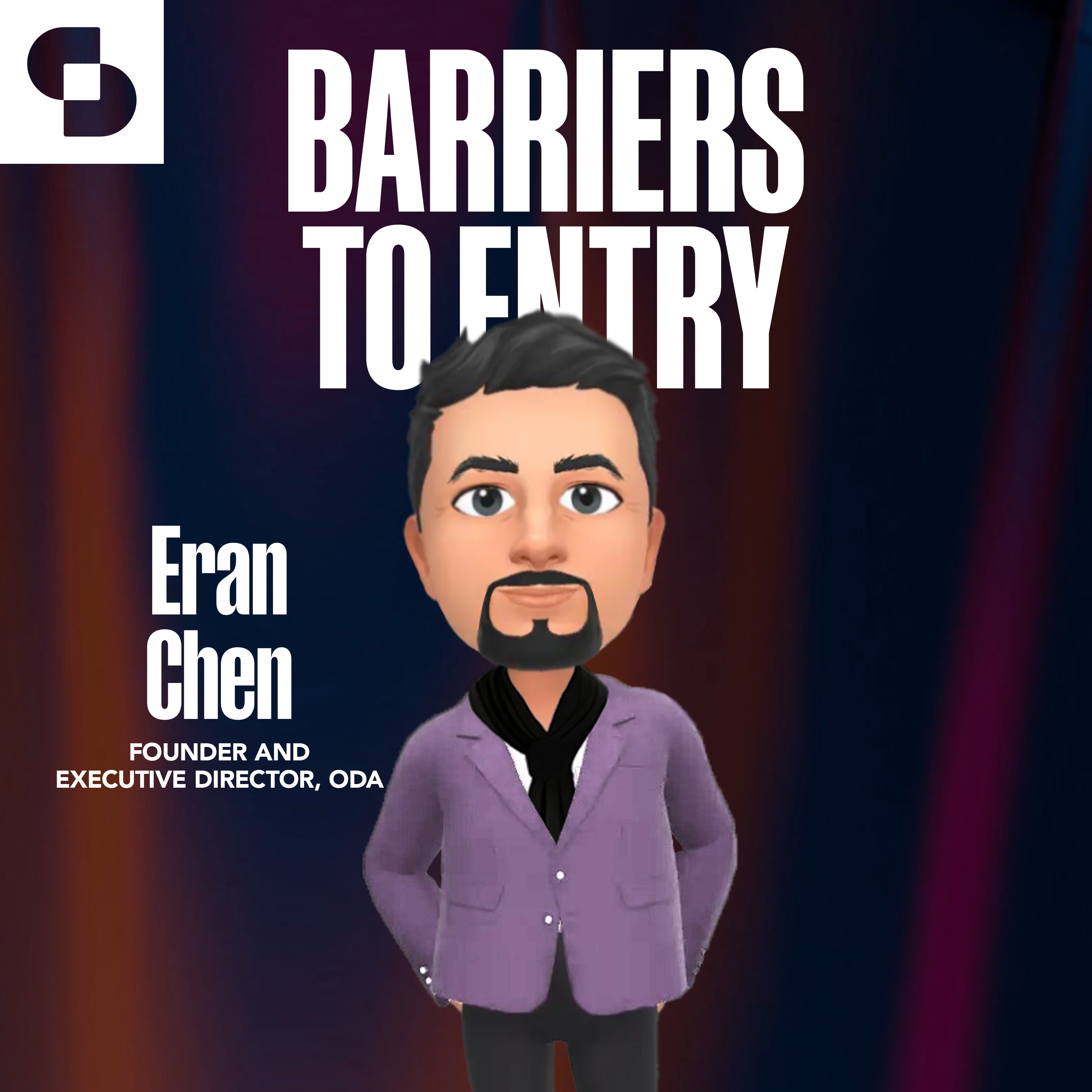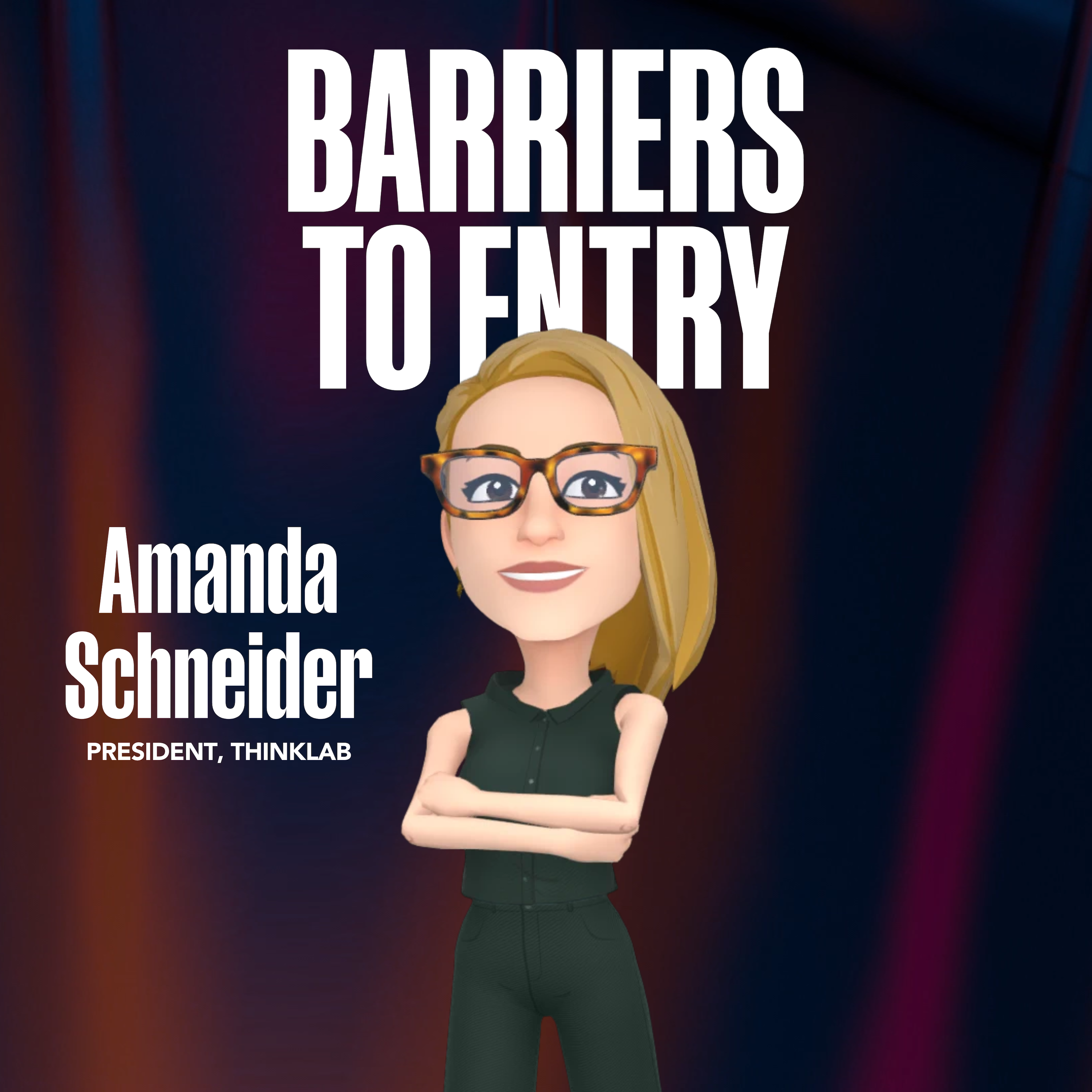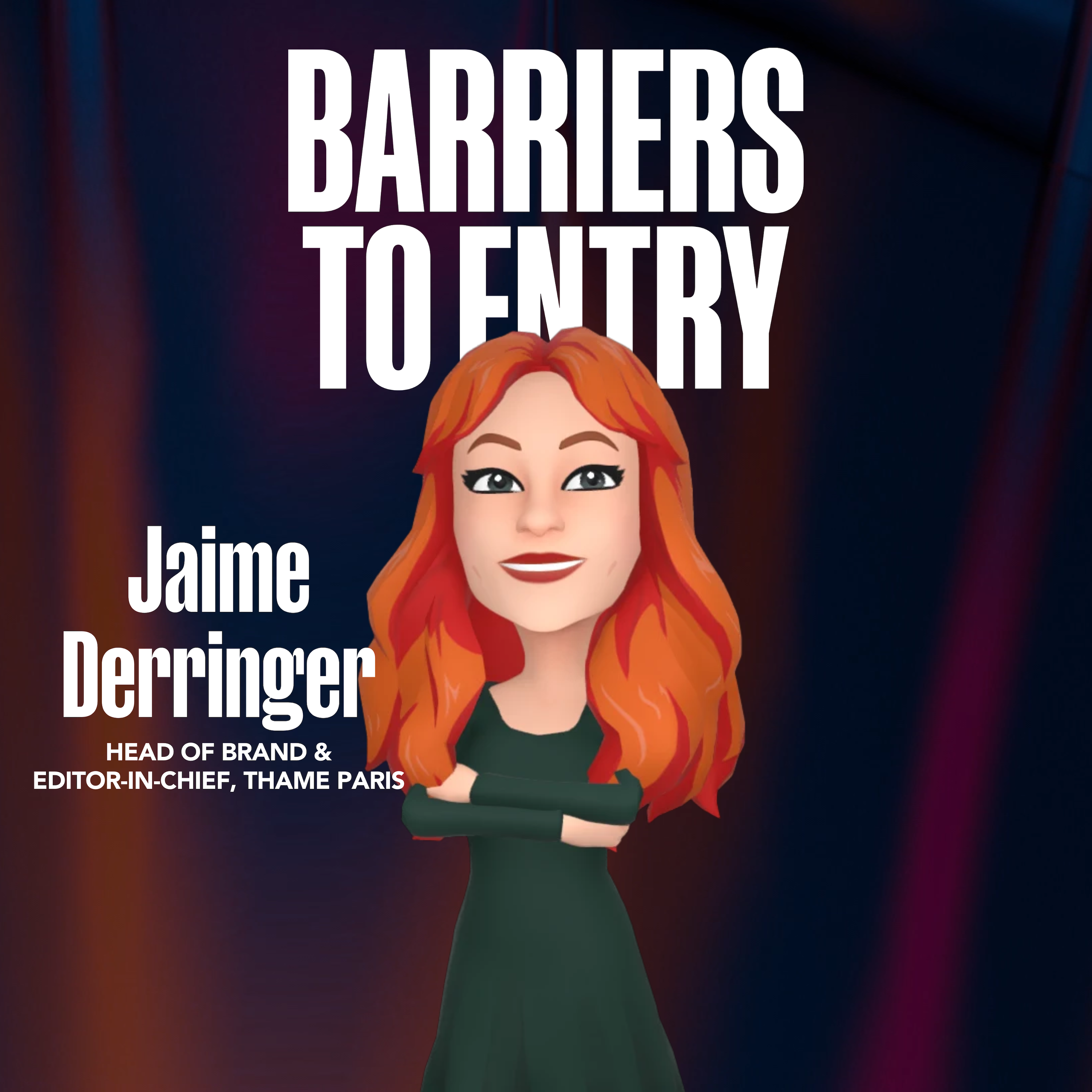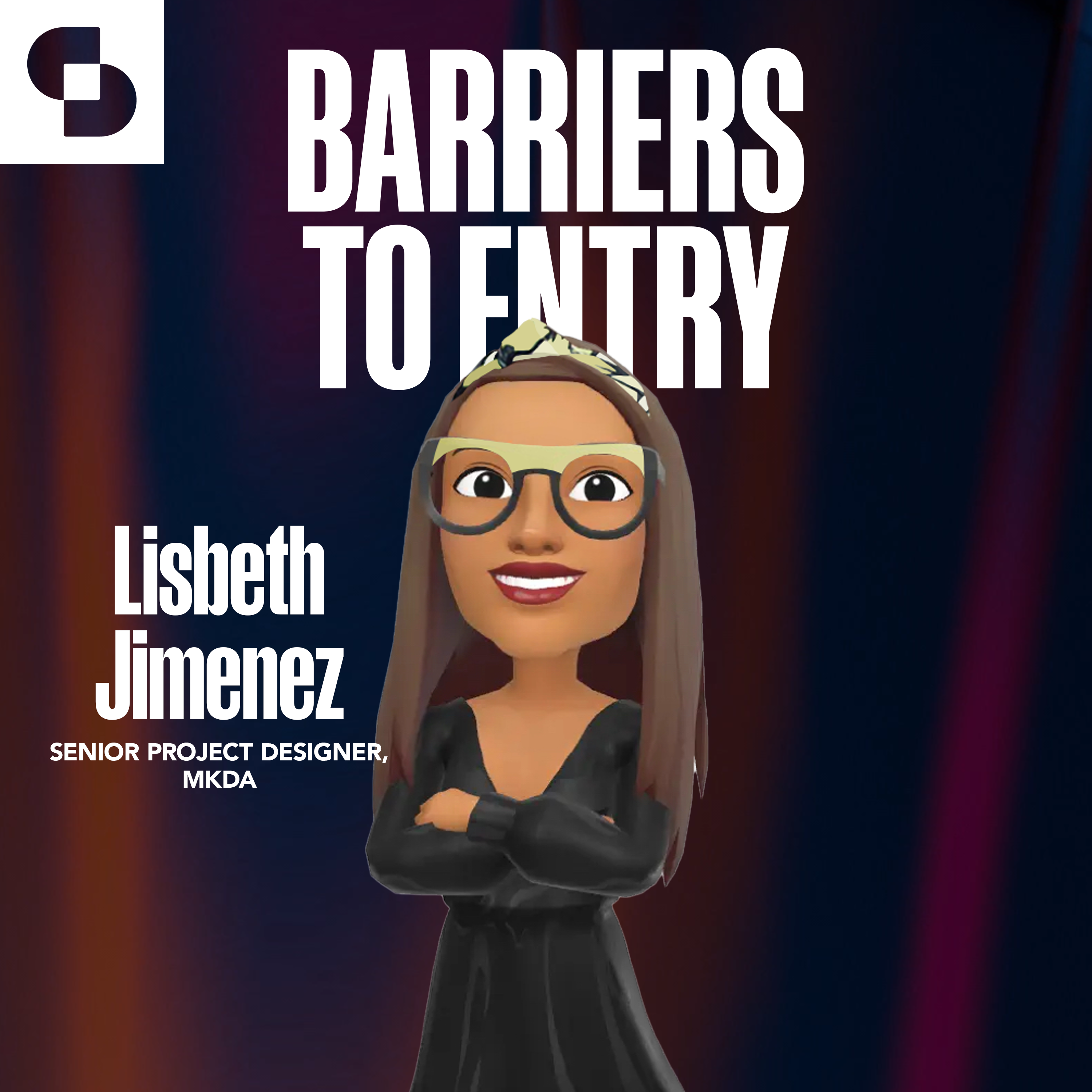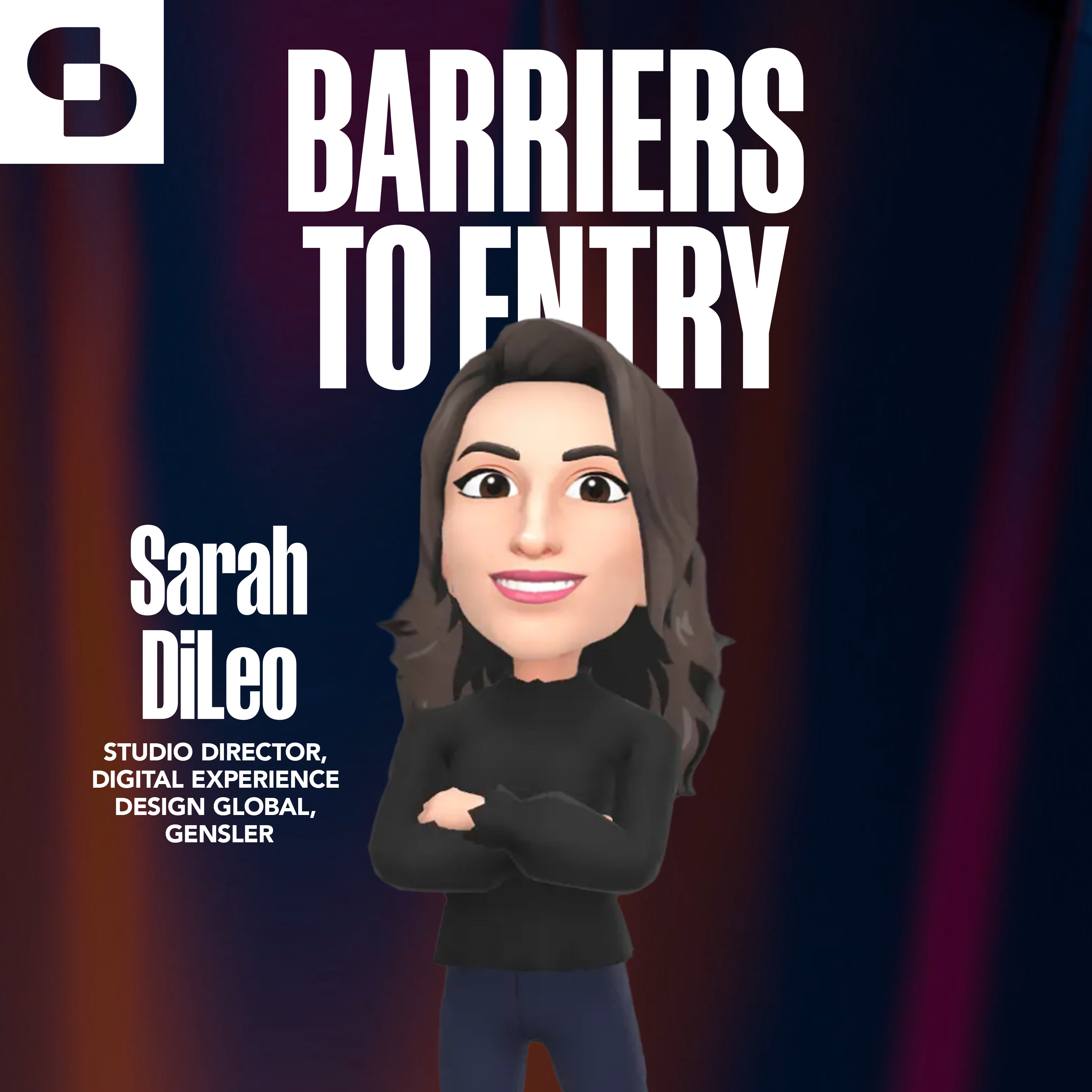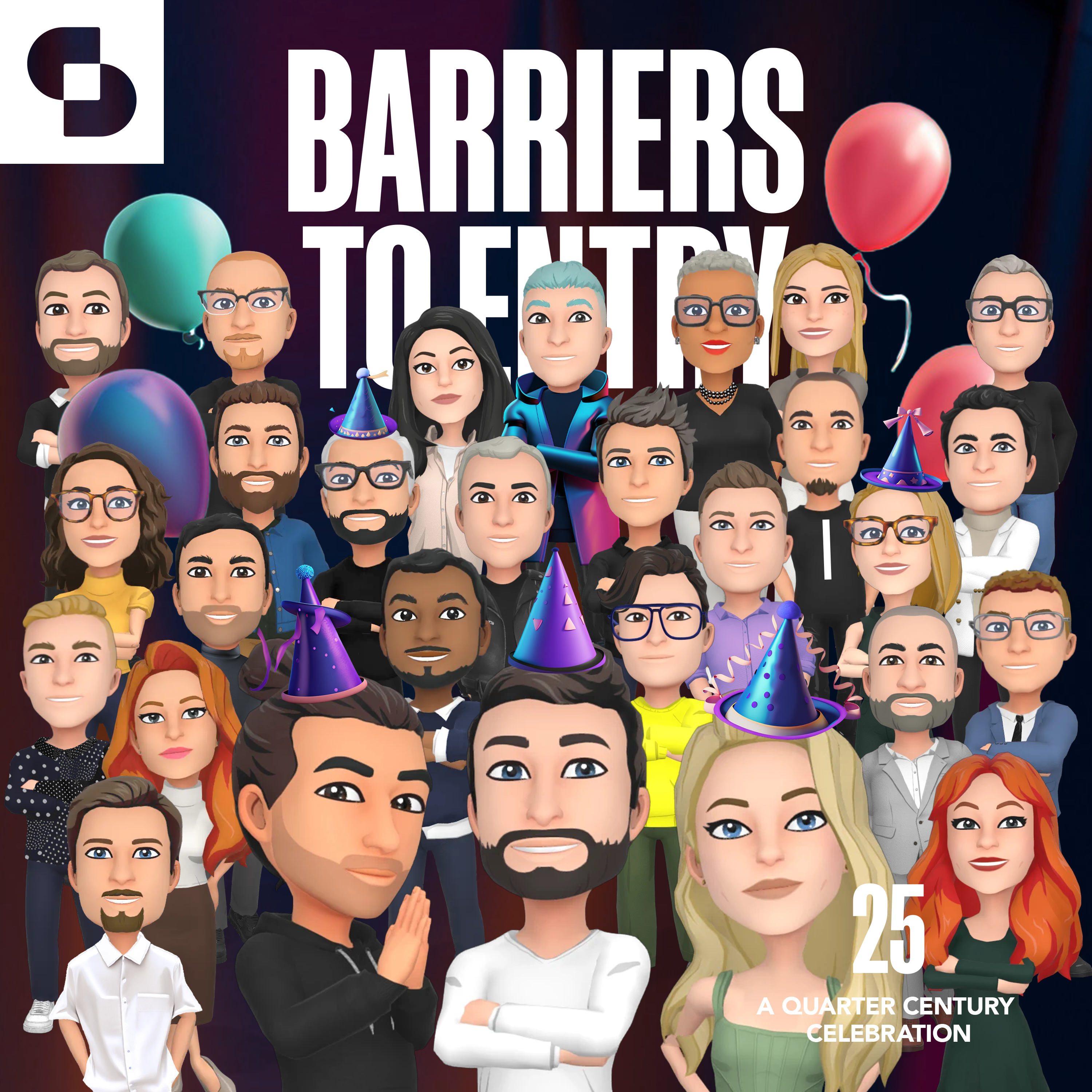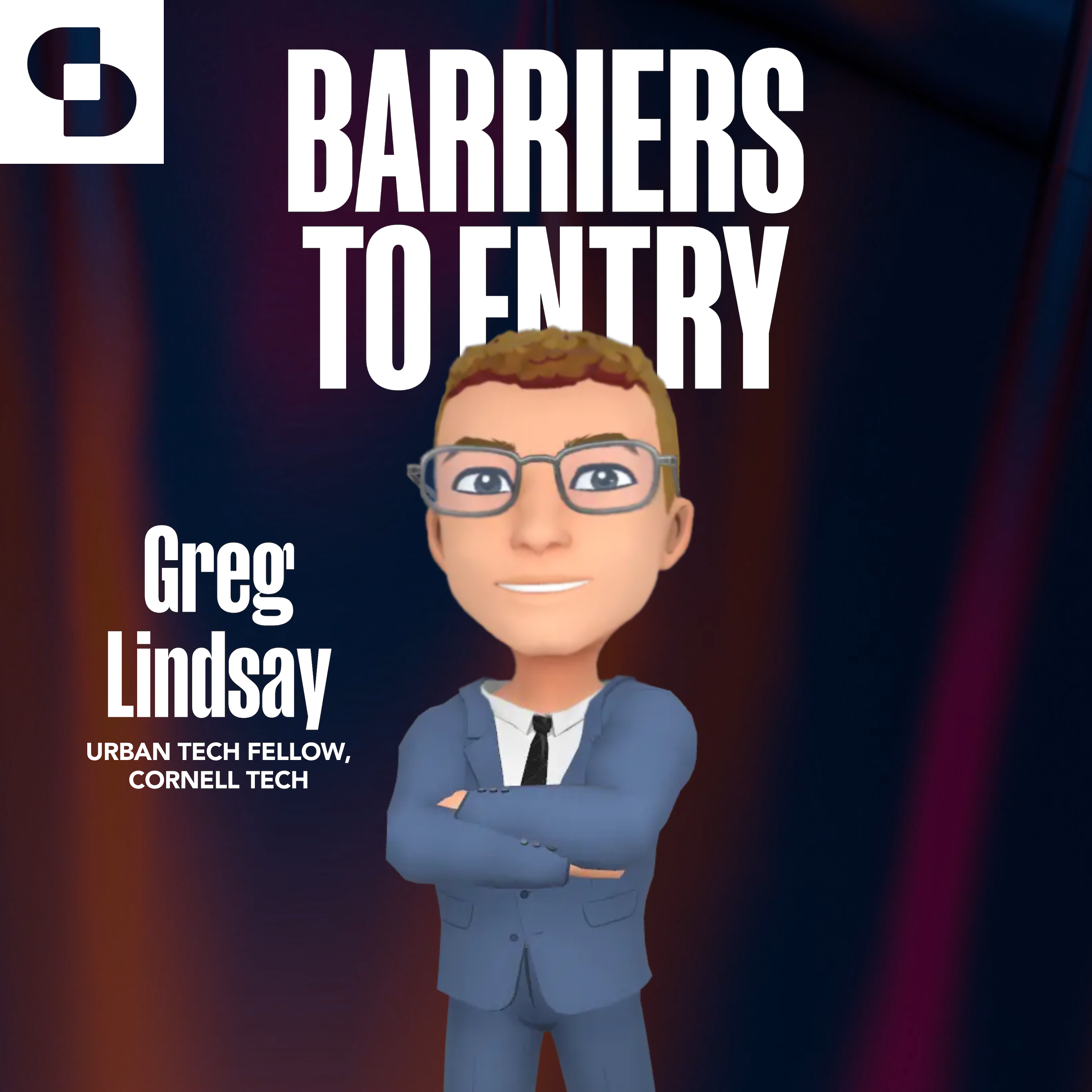This week on the pod, the gang receives a masterclass in embedding innovation into a business from the Director of Innovation at SLAM Collaborative, Keith Fine. Keith took a moment of necessity to create a virtual workflow at the onset of COVID and has used it to chart a path to redefine how the firm is now using 3D Spatial and AI technology to work both with its clients and internally. Tune in for a can’t-miss conversation as we talk about sourcing and inspiring talent, create a new competitor for Siri, drop some golf metaphors and teach Bobby and Tess a thing or two about Star Wars.
Connect with Keith Fine on LinkedIn!
Moments to check out:
- (5:46) Keith’s ‘a-ha’ moments and dealing with skepticism
- (13:24) Re-defining ‘the metaverse’ and breaking up with goggles
- (17:01) Building process and identifying talent for innovation internally
- (28:37) How technology is powering client-focused storytelling
- (38:55) The industry innovation view and steps to the future
Connect with our hosts on LinkedIn;
References and resources:
- S/L/A/M Collaborative
- Design Futures Council
- https://slamcoll.com/
- https://slamcoll.com/case-study/80/kaiser-permanente
- https://slamcoll.com/case-study/170/kaiser-permanente
- https://slamcoll.com/article/57/slam-teams-accelerate-design-using-3d-technology
- https://www.linkedin.com/company/the-s-l-a-m-collaborative/
- https://www.instagram.com/theslamcollaborative/
Discover more shows from SURROUND at surroundpodcasts.com.
This episode of Barriers to Entry was produced and edited by Wize Grazette and Samantha Sager.
Although the transcription is largely accurate, in some cases it is incomplete or inaccurate due to inaudible passages or transcription errors.
Keith Fine: [00:00:00] But I think right now, like, the word metaverse just upsets me at a very deep level. And I feel like a lot of the metaverse up until now has been built by trying to second guess what might be, might have a gravity, you know, or might be of interest where here we’re like, we’re really trying to solve concrete problems.
And taking these tools on the table and using them to do it.
Andrew Lane: Welcome back, dear listener to Barriers to Entry. It is the podcast where every episode we get into it with the leaders, the designers, the early adopters, and the influencers who are driving innovation in the architecture and design industries.
It’s the metaverse. It’s AI, it’s blockchain, and it’s all happening here. And it is the summer of BTE. I’m Andrew Lane. I’m here as always with my tanned and relaxed co hosts, Bobby Bonett and Tessa Bain and. Bobby’s got a new haircut today.
Bobby Bonett: It looks great. Thank you. I’ve got a fresh haircut. I’ve got a lot of excitement permeating through my body [00:01:00] because, as we talked about last week, we’re on the heels of the big Barriers to Entry reunion at the Perspectives Summit.
Took place in New York City just two weeks ago. We actually got to hang out with this week’s guest. Ad perspectives. Keith, fine. He took part in a panel, Andrew, that you happen to host. Maybe you can give the listeners a little taste of what the embedding innovation in your organization conversation felt like for people who weren’t in the
Andrew Lane: room.
I, I also wanna give myself credit for curating the panel Bobby. Mm-hmm. Curator host. Yeah. I went through the roster of some b t e guests. We brought back our friends, Matthias Hollwich and Erin McDannald. We put them together with. Upcoming guests who you’re about to listen to Keith Fine. And we talked to the group about different strategies and approaches and ways of thinking, but how you take innovation as a concept and embedded into your organization.
And what we heard was from three different leaders who have three really different origin stories and have come to this from different places, but have all, you know, arrived at a mindset [00:02:00] within their organizations where they’re really driving experimentation and. Helping their organizations to adopt new technologies, pushing the ways that they’re doing business.
It was an exciting conversation. And I gotta be honest. I hope they’re listening to this right now because we definitely threw a plug or two in for Barriers to Entry that
Bobby Bonett: day. I like that you said origin stories. It almost feels like it’s a, it’s a natural segue into our conversation with Keith, who you and he had a lot to say about a certain movie franchise, which I’ve not seen before Star Wars, but I’m sure a lot of our listeners.
I have probably seen it in the past. Tess,
Andrew Lane: Tess, what’s your favorite Star Wars memory?
Tessa Bain: Why are you asking me this? You know I’ve never watched Star Wars
Bobby Bonett: either.
Andrew Lane: Exactly. I just thought that it was important for our listeners to understand. This was a, this was a me and Keith thing. Me and Keith definitely had a moment.
Ah, you’re bros. Yeah. Me and Keith are kind of bros, but I think we all got along pretty well and I think it was a pretty great chat. What do you guys say we dive in? Let’s do it.
Tessa Bain: Today on the pod, the summer of barriers to entry continues as we’re live in New York at the Surround Podcast Compound at Penn One in Midtown Manhattan, and we’re [00:03:00] pleased to welcome a true innovator in the world of architecture.
He is a partner and director of innovation at S/L/A/M Collaborative and a member of the AIA Large Firm Roundtable and Design Futures Council. He’s taken the lead on some very exciting work using 3D spatial tech and AI to redefine the way his firm is working. Welcome Keith Vine.
Keith Fine: Thanks so much. It’s fantastic to be here.
Tessa Bain: You’re a partner, but also an innovation lead at SLAM Collaborative. What was it that led you not only into architecture, but into a role where you’re in charge of helping to drive the firm forward in new areas?
Keith Fine: I think the, the first spark of creativity when it really hit me that, uh, I was going down this path, I was going to date myself a little bit here, but I was about five years old when Star Wars first came out, like the new hope, like the, the real one.
No, yeah, you got to make sure which Star Wars. This isn’t Jar Jar Binks. Yeah, and being that this is like so embedded in my, you know, my spark of creativity and my path, my life path, if you will, I’m very, very high bar in terms of my analysis of those movies and we’re not going to go down that rabbit hole today, obviously.
Bobby Bonett: Is this where I reveal I’ve [00:04:00] never seen Star Wars before? Oh, wow, really? Okay, alright, I’m getting a
Keith Fine: lot of looks. Is it bad to end the podcast so quickly? Um, but no, I just, I think going in there, and I saw it 11 times in the theater, you know, which is outrageous, but it just blew my mind. It was like so detailed, it was creating this incredibly rich world with laser guns and adventure and storytelling and…
That I was like, that’s what I want to do. I want to create and I want to storytell. And eventually I got into theater and started building spaces. And, and that was a rush because you could, you’d envision it. And then, you know, days later you literally inhabit it. And it kind of like that became the addiction.
Right. And then, you know, took an architecture class and, and here I am.
Bobby Bonett: How early into that journey into building, did you start to look at yourself as an innovator and did that. Mindset of innovation immediately tie into your passion for architecture? Or was it around the time you were five years old, did you also think about innovating in
Keith Fine: some other way?
Yeah, no, that’s a, that’s an interesting question. As an architect or a designer, I think the, the [00:05:00] act of designing, in a sense is innovating. Like you’re creating something from scratch, from your imagination that’s, you know, better than what’s there playing tapestry or what have you. And so, yeah, I just kind of went down that path and, and dug it.
I’m
Andrew Lane: surprised you didn’t ask who shot first, Bobby.
Bobby Bonett: That’s right over
Keith Fine: my head, but honestly, shouldn’t even be a question, you know, like the fact that that’s a question or a meme is so upsetting, but of course Han Solo’s
Bobby Bonett: part. you who Han Solo is later. I know your first reactions to AR and VR weren’t exactly positive, despite the fact that you are an innovator in your role at Slam.
Tell me about, you know, why your initial reaction was skepticism, maybe on the positive end of the spectrum. I don’t know.
Keith Fine: Yeah, well, I definitely had a very profound experience. You know, that that sort of was a big pivot for me in terms of the technology. So we’re working with a general contractor and they had their head of V.
C. And he came up to me and said, Hey, we just started playing with [00:06:00] goggles and we’ve got all this software. We want to take your model of the building and we want to put it into VR and put the client in it. So that’s a horrible idea. That’s such a bad idea. We just permitted this and we have like a multi headed client where this one client you want to put in the headset’s gonna want to change everything.
And this other client over here that holds our contract is gonna have us in big trouble because we’re gonna miss our deadlines. Like, we need to hold the course. And then I started thinking about this. Like, I’m like, these bulky goggles and there’s all this setup and there’s probably a lot of behind the scenes work that we have to do on our side.
Like… Where’s the value? Like, we’re just going to spend, it’s going to be a big money pit for us. And our client’s going to think it’s gimmicky and silly. And so, and he kept on me. He just kept on me. And finally he, I said to him, I said, listen, I have a meeting in your office, you know, like next Tuesday or whatever.
After that meeting, let me walk out of that and I’ll walk into your cubicle. Have it set up and ready to go and we’ll do a test. I’ll get to walk into there. So I did that. Walked in, you know, got my, you know, sour face on, you know, trying to be nice. And I put these goggles on and it was just a game changer for me.
It was like, you know, and I’m [00:07:00] someone who like inhabits models in 3D on my screen and rotates them around all the time. And I was able to really understand that space in a very different way. And it was, it was fantastic. And so I think that. That didn’t necessarily tie me to goggles moving forward, although I thought that was our path.
We had another pivot down the line that helped us realize that. The goggles might have been a bit of diversion or have a very specific space, but it really opened my eyes to using the gaming engine and overlaying that into the built space and inhabiting it and then using that to make decisions. And so, yeah, so that’s where skepticism really kind of pushed us.
Are you sympathetic
Bobby Bonett: to skeptics now or are you frustrated by skeptics when you have to deal with them? Because I’m sure you deal with them all the time. Yeah, no,
Keith Fine: I’d say it’s both. I think skepticism is such an important part of innovation. Uh, cause, and they cut the legs out from under you, you know. And you’re sitting here with all and you can see I’m a pretty, you know, lively, passionate individual about what I’m doing and I’m trying to sell people and you get the skeptics in the room are sitting there just throwing darts.
Um, but what I’ve learned is that you need to engage those people. I think the skeptics are the [00:08:00] people that help you keep it real, keep you grounded. You need to the better people who are designers or innovators are people who. You know, they shrug off the hurt feelings, and they sit down, and they truly listen to, you know, what was the feedback?
Is this something that’s going to, you know, maybe help me in terms of selling this concept? Maybe they didn’t understand what I was doing, or maybe there’s some components with the path I’m on that have some technical barriers that I need to overcome that I didn’t realize. And so, either way, you’re getting really valuable feedback.
So, it’s frustrating. But it’s a frustration you have to like absorb and embrace to move forward and excel. So you talked
Andrew Lane: about kind of the different paths that you went down and we, like, I love the story that you’ve told us before about where you sort of had a necessity that drove kind of the innovation path that you’re on right now.
So, maybe you can talk a little bit about that moment and where that’s
Keith Fine: taken you. So, this is the other pivot, right, that we were talking about. And this is, again, we started a lot of this technology exploration in healthcare. So, a lot of these stories are going to speak to that. And this was a very complicated, fast track [00:09:00] procedure center, surgery center, and imaging center.
It was like all, like a mini hospital with infusion for radiation oncology and cancer treatment. So, it was a lot going on in this one building. And we had really started after that first, you know, excitement. about using that technology, we started getting a lot of more assets into the building so we could, you know, some of that we were able to kind of get from our client, others we had to build ourselves and we made some investment there, but our goal was to like get every single space because we have to go and review every single room in the entire facility.
And get it built out with all the equipment and everything in their case work, yada yada. And so, we would then walk through the client in there. We were going to do like a whole digital circus. It was going to be three separate monitors in a conference room. We had set three separate rounds of meetings that we were going to have.
So we’d have a week of meetings and the meetings were like grueling ten hours a day. Uh, with clients that were cycling through for 18 departments, but we would be there 14 to 16 hours with a commute. And then you’d have two weeks to like get everything incorporated that they gave you as feedback and then do it a couple more times.
[00:10:00] And so we were, and we wrote PR stuff to get the doctors to get their schedule set. And then all of a sudden, two weeks before this meeting, the first wave of COVID hits. And we get a call from the client and the client’s like, okay, I got a lot of news here. Some of it’s good, some of it’s bad. Honestly, most of it’s bad.
The good news is, is the doctors have committed to the times that we have. We said, great, because we know we’re behind schedule. We really need to pull this together. He goes, well, you know, the, the other news is that the conference rooms that we had reserved to be able to do it, they planned everything around.
Well, that’s full of beds right now for COVID patients, so we can’t use that. And on top of that, like because of our policy and the dangers of COVID, we can’t have any two people in the same room. Meanwhile, our entire staff is now their first week working out of their kitchens and dining rooms and their internets drop in and you know, it’s like, so we’re like, okay.
And they said, okay. And one more little bit of bad news is the doctor said that this is likely the only time they’ll be able to meet with us with this crisis going on. So. You need to sign off the entire building in one round. Instead of two and a half months of three separate rounds of meetings, you have to [00:11:00] do it all at once.
And so, after I, you know, got up off the floor and shook my head a couple times, we got the team together and we just worked the problem. I mean, we just got down and we developed, like, redundant roles. We developed this whole process. And this process is now, like, the cornerstone of how we’re interfacing with our client and delivering work.
And it was just profoundly impactful. And we were able to sign off 15 of those 18 departments. And that’s when we kind of looked at each other and we’re like, something’s going on here. This is, this is pretty cool.
Bobby Bonett: Do you think that the urgency that the departments felt also, we talked in a past interview about the pandemic being a force for folks removing noise in decision making.
And do you think that Maybe your clients also recognized they needed to remove some noise in their decision making. Maybe you were helped a little bit in the fact that the doctors recognized we got to move fast also.
Keith Fine: Clearly, the pandemic was a catalyst for a lot of things, you know, and I can’t put myself in their shoes relative to that.
But we did a lot of work in terms of how we curate that model to keep the team focused so we wouldn’t [00:12:00] have any extraneous distractions to keep them on par. And another thing about editing out that noise, I think that also is a really good statement relative to the technology that we were working with is that Where, you know, previously we’d have dialogue with the client and, and they’re not, they’re, these are doctors and practitioners and nurses and, and department heads and they, they don’t read plans.
You know, they do, you know, every three years if they’re redoing their department or something and they get in there and you get really weird questions like, you know, every architect’s heard this like. What’s that table doing in the middle of the room? Do I have to walk around that? And you’re like, you know, that’s the room tag.
We weren’t getting those questions. Like, all that noise, to your point, was gone. And they were inhabiting the room. And instead, like, a lot of times in these buildings, there’s a lot of stuff that gets put in and moved in, like de germers. We don’t have time to deal with that during the design of the building.
We’ll just figure that out later on. We populated those in this model and I remember turning at one point we were in one of the rooms and the practitioner turned and said, wait, wait, wait, turn back. Let’s walk over there, you know, cause they’re literally in the room. I need you to relocate those because you have like the light switch and then you have the de germer [00:13:00] and then the gloves.
And it’s like, you know, I need to move some of that order around based on the flow of the way I’m leaving the room right to the room. And I remember the exact comment, but it was like, they were, they were seeing things in their environment. Cause that was their natural way of inhabiting that space. And it really helped them.
Transport into that space to drive decision making in a very different way. And I think we were able to come out of that with a set of documentation that was just so much more accurate than we’ve ever put together before. I
Andrew Lane: think what’s really cool is you, you obviously, you just gave an example there.
You learned things in live time that maybe you weren’t even expecting when you create an experience like this for the clients that you’re working with. What are some of the other kind of unexpected things that you’ve learned and have become maybe even more core as you’ve evolved this
Keith Fine: approach moving forward?
Well, I mean, I, I’ve detached myself from the goggles, I think, and I didn’t say detach. I have plans for the goggles because I think that, yeah, I can verify Keith
Andrew Lane: does not have goggles attached.
Keith Fine: I’m very, I feel like goggles are a tool that are evolving that are going to have a specific place and I think [00:14:00] they are a profoundly powerful tool used properly.
But I think right now, like. You know, just the, the word metaverse just upsets me at a very deep level and just so much of the pieces that have been built in there. I feel like ours, you keep coming back to this, how this was built by necessity. And I feel like a lot of the metaverse up until now has been built by trying to second guess what might be, might have a gravity.
You know, or might be of interest where here we’re like, we’re really trying to solve concrete problems and taking these tools in the table and using them to do it. And it’s a lot more powerful, I think.
Andrew Lane: Yeah, I think that there’s a lot out there right now that’s trying to just replicate the physical, you know, and, and that’s fine and nice.
But, you know, I think people really see the promise of 3D spatial when you’re, you’re trying to create something that’s not possible, right? Like you’ve used it to create something that doesn’t physically exist yet. And I mean, allowing it to start to create efficiencies and change processes and change the way that people think and collaborate.
I think that [00:15:00] that is what this, the promise of this tech really is when you start to get it at a really tactile and tactical and useful level. Where do you see the real potential for this starting to go? Or what have been some of the big eye opening moments that you’ve had with your clients as you’ve brought them into these
Keith Fine: experiences?
Well, I mean, we’re seeing the process that we’ve put together and the way we’ve structured it as a real differentiator. And we put a lot of work into making it efficient because that’s the challenge, right? Is how do you make this efficient? Because, you know, we’ve talked to peers and such, and they really struggle with trying to develop this same workflow.
And I feel like we were able to pull it off at our initial phase and be kind of in the black, you know, we kind of, we’re net, we’re neutral in terms of that. And that’s how we market ourselves generally. But there’s a lot of, you know, ad services that can go to it that can further enrich. But I think, you know, we’re looking at, you know, big data, we’re looking at AI, we’re looking at being able to push this straight to fabrication.
So I think this becomes a platform that’s really going to change how we deliver buildings. I think I almost see the way that we’re [00:16:00] going to design, interact with our geometries. And proofread our geometries and then move them through and validate them and get them produced is going to be more visually managed, not by, I mean, it’d be in combination with technical drawings, but like we’re proofreading buildings with overlay of built space and looking at existing conditions as they’re being built relative to our overlaid interiors and the infrastructure of the building and validating that in, I was doing it in the goggles.
So we’re, I’m seeing like there’s, there’s so much potential to this workflow. You know, you’re going to start being able to talk to your AI, and you’ll be able to just give it, you know, hey, take that cabinet and move it over here. And then you walk in through, oh, turn off the sheetrock in the ceiling. And oh, move that data port over.
Oh, this thing is going to need power and data, and your electrician is going to go and drop it in the model while you’re there. You know, and AI is going to connect it to the infrastructure, to the panels. Like it’s, we’re on a path that’s really outrageous. Like it’s, you can see, you can see it. It’s tangible, you know, it’s like, like really thick fog, like cotton candy.
You can just bite into, you know. [00:17:00] Yeah, right.
Tessa Bain: Well, you talked about the process of your clients adapting to the new technology that you’re presenting them, but I’m curious about the process of what it’s like onboarding your team internally to the new technology and obviously very rapidly.
Keith Fine: Absolutely. No, that’s a, that’s a really, really good point because even as we present and we talk and we reiterate internally.
About how we’re doing this and we’ve developed like a whole structure internally between different studios and innovative leaders within the team That are sharing resources and whatnot if you have the wrong person driving that model, you know, they’re in a closet there I mean everyone knows the same pitfalls when you have more of that in the headset, right?
And so You know, we have like, you know, David in our office has created this driver’s ed course that teaches you how to manage your camera. And we have a lot of discussions about how to curate your monitor and the different applications that are popping up and the extents of those. And, and what, what different softwares are going to be on the screen at the same time in pairs to be compared to each other.
And, you know, sometimes you’ll spend an hour, hour and a half. Just setting up for a [00:18:00] meeting just getting your screen and all your applications open and getting yourself ready to interface So there’s a lot of training that goes to that and then you know how you move your camera How you keep your client from getting motion sickness and you know, ask him to look away If you’re speeding down a hall, there’s so many subtle little things But it starts to help you realize that you’re you’re like a tour guide, you know, you’re really Curating an experience.
Uh, and I think the next level of that too is starting to infuse a bit of branding to that as well. And so we’re, we’re kind of exploring that too. My
Bobby Bonett: mind is still blown by the challenge you faced right on the dawn of the pandemic, you know, trying to figure out how to pull together these, these meetings, what, what sounded like overnight as you continue to embed innovation throughout your organization.
What are the processes you undergo? You know, you’re leading that throughout the firm and when you, when you, and across multiple offices too, and exactly across multiple offices. So you talked about, you know, training the team in the processes you’ve adopted already as a firm, but when you bring in new technology, when you bring in new innovation, I’ve been calling the virtual assistant you’ve been referring to as Keith in my mind.
So at some point we say, Hey, Keith, move the, move the table over [00:19:00] here. How do you envision? Embedding these new processes, these new technologies into what already sounds like a pretty amazing differentiator
Keith Fine: for slam. I love that. I think I’m going to have to make that my legacy in the firm that we, if we do develop our own Shirley tie, that’ll be called key.
So like 60 years from now, versus Siri. So I think, yeah, well, first of all, I think as a clarification, my, I take my role of director differently. I’m not like sitting up on high, coming up with the ideas and giving direction. I really see myself as. As a curator of the team, a support for the team, right? And I put a lot of dots together, but I spent a lot of time digging through the company just to try and find our best and brightest people.
We also have a learning platform that we’ve created internally. Uh, I mean, knowledge exchange is a huge part of the DNA of SLAM. That’s, it’s like really a lot of what we’re about. We’re a very technically astute firm. We’re one firm mentality in terms of our culture, and we leverage the best people for the jobs most appropriately to really make sure we’re given the best product.
And so with that one on the major platform, it becomes a great like propaganda piece almost where we [00:20:00] curate great innovation or things that are going on. And we. I give these presentations twice a month to the entire office and then from those, sometimes if it’s a good technology, we have different like a tips and tricks, we’ll do knowledge exchanges that spin off from that, but then we have little clusters of activity where you, you know, if I get contacted by someone who’s really into 3D printing, you know, and so I call Leon in Orlando and I dig in and what’s he doing?
I encourage that and we develop a little bit of a petri dish of, of classes that are going on there and then we move that to the Slam Talks platform and then we make a knowledge exchange for that. Yeah. Okay. On, on what we’re doing with healthcare and, and rolling out this visualization into other market sectors now, we start with a base of, you know, the, the leading people in each of the studios to make sure we have representation so we find what our best practices are and generalize those and document those and then start, you know, working with our Revit directors to kind of get asset correction curated.
I mean, there’s a, there’s a lot of different facets to it, but it’s just about spinning plates. Engaging people, constantly hunting, digging into things and understanding how they can go together and getting those people together to [00:21:00] make them far better than you ever could yourself.
Bobby Bonett: And now you have clients who seek you out specifically because of the way in which your firm approaches innovation.
Keith Fine: Yeah. I think people, as we’ve been sharing the platform and the demo that we gave you here before, there’s, it generates a lot of excitement, a lot of interest, and especially in these, these technical spaces. Cause I think a lot of clients are recognizing that. Their biggest enemy is themselves sometimes and that they continually change their mind and they’re realizing that, hey, if I can put these people, I have this one supreme user that’s running, you know, whatever, the surgery center, the, that they’re going to, you know, if they can understand it better, they won’t make as many changes, you know, it’ll just like lock it down and they’ll love it and move on.
And so that’s, that’s the hope, right? Well, we know you
Tessa Bain: can’t talk about this in detail because of lawyers, but you’re working with an AI company that’s focused in the A& D space. How are you approaching the potential of that
Keith Fine: technology? Yeah, well, it’s a challenging one to navigate. It’s an exciting space.
It really starts to open your eyes in terms of [00:22:00] Where our industry is moving and how quickly it’s moving. So what we’ve done is, I’ve talked about some of these cluster groups and we’re developing a work, a best practices workflow. And then from that, we’ve realized that we’ve already started to generate a lot of different assets.
So we’re then also defining a, what we’re calling a forward leaning workflow. So that’s sort of like, okay, we need to like, Get best practice, get everybody generalized, and then move us into this, you know, finish building out these assets and tying them together so they work properly. And then at the same time, we’re developing an aspirational workflow.
So, the goal is, is to move everybody to the forward leaning, and then start finding bridges to the aspirational, right? So, those bridges can come from anywhere, and we want to empower everybody to be searching and reporting back so we can talk about them. And so this engine and working with, with, uh, we, we’ve been speaking with a couple different AI companies, is, is looking at.
Walking through our workflow and our forward leaning and our aspirational and understanding what they have built already within their ecosystem. That can be some of our first bridges. What are our low hanging fruit [00:23:00] bridges that we can take advantage of for as low a cost as possible? Because part of my entourage is our president here.
And, you know, there’s, there’s like, I gotta bring value to the table before we can get to invest in some of these. But I think, you know, as we do that, we’re going to get momentum and the ball rolling, and that’s going to spiral into kind of. That’s the hope anyway, and so that’s kind of how we’re trying to approach that is creating these These, these workflows and then hunting for bridges.
And we believe we found some really good partners, one in particular, to start building those bridges. And we’re, we’re in process of that now.
Bobby Bonett: Have your team members and colleagues embraced AI as much as you found they embraced the spatial tech that we
Keith Fine: talked about before? I think, and we go back to the skeptic comment earlier, I think there’s definitely embracement.
The leadership of our company realizes that innovation, technology, and all of this is our future. But I think also they’re, they’re kind of establishing a path that I need to, you know, become a little bit more of a business plan writer. And document this down, establish the steps and what our spend is going to be and really define [00:24:00] at a, at a very detailed level how we’re climbing into that and show the proof in the pudding.
But it’s, it, you know, it is something where, you know, I always, I have this kind of, uh, uh, uh, phrase that I, I like to use is that, The further you are up the mountain, the harder it is to see through the cloud layer to know what’s really operating on the ground plane to get things done in the world. And, and as, as you deal with different folks in the leadership, sometimes they’re not as connected to the minutia of how you’re dealing with the interface of Revit models and families and all these things.
And so there’s some repetition on presentation and whatnot, but no, I think, I think there’s, there’s absolutely embracement. It’s just a matter of making sure we’re really smart and strategic about how we do it, which is. Which I embrace. I think that’s what we really need to be doing. We need to be smart about how we do it.
If we got to be tactical, cause there’s so much you could, there’s so many different opportunities, you could just get lost chasing your tail forever. Almost. I never get anywhere. Do
Bobby Bonett: you imagine the impact that AI will have on the way in which your firm does work will be on par with what 3d spatial tech has?[00:25:00]
Keith Fine: I think that the AI, the aspirational platform that we’re moving forward to, you know, in my fantasies, in terms of where I think we could be in 5 to 7 years, what we do today would almost be unrecognizable. Wow. Yeah,
Andrew Lane: that’s exciting. So, you know, you’re obviously thinking about this in big ways, How’s it changing the way that you’re thinking with the talent?
I mean, let’s start with inside the firm. There’s a lot of, you know, re skilling and talent identification, I’m sure. Um, that’s happening. So maybe you can
Keith Fine: start there. And that’s a complicated question. I think there’s, there’s so much going on relative to the generational shift. You know, in a big picture, you’ve got, you know, the boomers who are moving into retirement.
And then you have this smaller generation of Gen X, which I’m one of are trying to hold up, you know, the middle, and we’re just being crushed. So there’s, you know, there’s a gap. There’s not enough extras in the world because extras rock. But, but we’ll watch Star Wars things. We grew up on Star Wars. Thank you.
It paved this path. But I think what we’re finding [00:26:00] is, is that as, as you start looking at this workflow, where traditionally architecture has been kind of a mentorship process and you learn by doing and by, By being saved from mistakes by your mentors or by making mistakes and you’re you’re building all the different components of a document set as you move forward in your career.
And you over time develop more and more expertise from that experience and lessons learned. And now we’re going to be going into situations where you’re going to be conceptualized something with, you know, a younger group of people because you’re losing that historical knowledge out the door to the golf courses, right?
And they’re gonna. But they’re not going to have that opportunity to kind of grow in the job and we’re going to put it through these AI tools and, and the AI tools right now, as you’re working with a lot of them are there in their infancy, like people talk about all this capability and I’m hoping that five to seven years is a realistic window.
People say it’s coming in the next 15 minutes, but it’s not, there’s a lot to build. And a lot of these early iterations, especially as you dive into it. The, the product that comes out is nowhere near what a human could do. And so the humans have to go in [00:27:00] and proofread it. So that skill of QA, QC is going to be much more in demand of people who are like midway or further into their career would have that technical expertise, have that programming and planning expertise to be able to correct those items where we don’t have that coming out now.
So we’re trying to use big data to solve that. to some degree so we can start embedding a lot of information, capturing information before tea time and not tea, but you know, tea and off. I’m using like my hands and this is a podcast, but you’re getting everyone out on the golf course. We’re with you. Yeah.
But I think as you think about, you know, the, the younger people are coming in, what, you know, you need digital learners. We want people to be more client facing, I think. So you’re, you know, or you could have a lot of people in old school who might be a little more introverted. I think we might have a lot more client facing people.
This process has shifted a lot of our younger staff into those positions because they’re building all the components and they’re driving the model during the meeting, which is incredible because it really fast forwards their career because they’re hearing the details that are driving the conversation, the urgency from the client where before we couldn’t afford to [00:28:00] bring them to the meeting.
So, uh, A PM goes to a meeting, he’s doing his song and dance, trying to take minutes, comes back, gives them 60% of the information, gets angry at them, you know, in two weeks because he hasn’t talked to them and it doesn’t have, you know, even 40% of it in there and they’re angry at their PM. But now they’re in the room and, and we found they started doing a lot of it, almost all of it in real time while you’re, so now you leave that meeting and you’re ready for the next meeting instead of coming back and having that miscommunication.
So it is augmenting their, their learning curve dramatically. And so we’re, we’re trying to find people. That, that just really work well as a team. Like team is such a big part of our ethos and our culture. We’re like a work family and that’s who we are. I think the other thing
Andrew Lane: that I heard through those, those words, and when you weren’t talking about golf was, was storytelling and that you are really using these tools to tell a better story and to even immerse your clients in the story of the design that you’re creating for them.
Uh, can you, can you talk about like how you’re thinking about and honing that and maybe how the tool. Is [00:29:00] helping to really humanize like, I, cause I, I feel like that’s such a barrier when people think abstractly about. Quote, unquote, the metaverse, this is actually you telling the story of your firm in a different way and actually being to your point, more client facing and more interactive with them.
Keith Fine: So I think there’s a few levels to that. One, there’s, there’s the story we tell when we’re meeting with clients to let them understand what the platform is. So we’ve kind of curated a story, similar to the one I told, you know, with the demo that we did prior to help some understand the benefits that are there.
Right. So that’s one level of story, but the other, which is probably more what you’re getting at is You know, instead of looking at a checklist of items that are in a room on a floor plan and an elevation to make sure they’re placed properly, we’re really having dialogue about practice and how that space is utilized.
And when we talk about relationships of a nurse station to, you know, the pre post beds and the view that you have and how quickly you can get over there, like, We’re now having discussions and storytelling about [00:30:00] their daily work and how they operate. And we have, we have a whole nother thing I’ve even shared with you guys, which is like a, I don’t even know how to describe it.
It’s like a, it’s a strategically lower acuity. Mock up with an AR overlay. And so it’s the same kind of thing where you’re able to build a lower acuity room and we we get the core Components in the room and then we overlay that with QR codes to an AR so you can see everything that’s actually there And then the practitioners are in the same thing there They’re working through their life and their storytelling of their day to day.
So it’s a different way of interacting with them while they’re doing all this. And then because it’s a lower acuity space, it’s easier to reconfigure and kind of get right on those bigger moves or adjust the model without delaying your project or having to order all these different components to get them in the room.
And so it’s, it’s a much less expensive way to accelerate your project and connect them to that story of how they operate and work.
Bobby Bonett: So Keith, you mentioned a couple of times a demo that, that Andrew test and I were, were lucky enough to see right before we went, um, on air, um, as they say in the biz and, uh, and I’m, I’m hoping that [00:31:00] you could give, uh, like a quick kind of audio overview of what we saw and I’ll, I’ll set the scene a little bit.
So where. You know, you’re at with, when you’re working with a client in an analog state is a client’s looking at a floor plan and you’re explaining the layout of the space, basically. Here’s, here’s the upper left quadrant. Here’s the room that we’re, that we’re walking you through from an architectural standpoint, the client says, I’d like to move this desk over here.
And what you’ve done is you’ve taken that experience and gamified it in some way. So can you kind of walk through. How the client experience has changed from a reviewing a floor plan standpoint. And then you mentioned someone behind the scenes making live changes and how that works from a client perspective.
I can give
Keith Fine: a bit of an overview. Basically, you know, we, we use a gaming engine for visualization and we connect that to the Revit model in real time and we walk through it and we’ve, we’ve put a lot of energy into kind of our asset building and how we curate that and build that model. We keep a chat going in the background.
We have people making modifications while they’re doing [00:32:00] it. So you have this experience from the client side. The first time we did it was with Dr. Cacciatorian. So if I could tell that story, it’s probably a better way to do it. And
Andrew Lane: I’m like, I’m coming from a background long ago in television, that you’re talking about a television control room here, right?
Like you’re putting on, you’re putting on a show. Totally. Right. And you’ve got, you’ve got a lot of tech going on in the background
Keith Fine: that’s behind the curtain for your client. We’re talking, we have a separate feed going. We’re sharing screen captures. It’s like, you know, we’re coordinating loading times.
It’s like, it’s a whole thing. And we also, at that point, when we first did it for the surgery center, we had everyone cross trained. So that no matter who was, like, so, like, settings were all identical, like, everything. So if someone dropped, the other person could grab screen and the client wouldn’t know the difference.
They would just be like, Oh, hold on. We just had a little blip. I have to go back to that room. That was it. But with, with Dr. Cacciatorian, we were working on a, this was the first project where the contractor wanted us to pull the building into. And thankfully he convinced me to do that because we actually had another groundbreaking moment with that.
So, we’re at a OAC meeting, owner, [00:33:00] architect, contractor, during construction, in the construction trailer at like 7 in the morning. And we’re in the middle of framing of the project and all of a sudden Dr. Kachatorian runs in there in a panic and he’s like, Oh my god, he’s like, we’ve got a problem. He goes, we designed our procedure suite for overflow for an exam room and we’ve got all these monitors in there that are for the patient.
And he goes, but we just got this new suite of software that I need to use that’s going to be like so cool, but I need to see it while I’m doing procedures. And now that monitor’s behind me. And so we basically took our model to the trailer in a, in a laptop, cause this is, you know, like eight years ago, so we weren’t in the cloud yet.
And we said, Hey. Catch, don’t worry, we got this, right? Although I’m not supposed to call him that. Yeah, I was
Tessa Bain: like, that’s
Keith Fine: really cool. He’s awesome. He’s like just one of the great doctors I’ve ever worked with. And really embraced the technology. I said, listen, come back next week. We’re going to bring a VR headset.
We’re going to put you in your room. We’re going to fix it. He goes, what? I said, trust me. So he comes back the next week. We have the whole thing set up. We put him in the room and we had, you know, like a, we had a medical planner in [00:34:00] the room and we had our code references, we had standards, we had everything we needed to make real time decision making in the construction trailer and we had a monitor up so we could see what he was looking at and he sat in the room and he basically.
Pantomime’s doing his procedure and we were moving the monitor. Try it over that wall. He goes, no, a little bit more to the right. Well, no, now you’re in the clear space that we need for this for infectious control. Oh, okay. Yeah, I know. Well, let’s try it over. And we, we kind of worked out that room like within, you know, half an hour, 40 minutes, we had everything adjusted.
And then, uh, that was like midweek. I think we did our OACs on Tuesday for that project. So I think the next Monday we issued a corrective RFI that changed all the infrastructure and adjusted it before they even put Cheat Rock up. And so that was, you know, that’s kind of gives a good sense of we, we’ve extrapolated that now to.
Bobby Bonett: And incredible efficiency in the construction process. Oh
Keith Fine: yeah. Oh yeah. It’s awesome. And, and our tools now we’ve, we’ve, we’ve found as we started to invest in building these assets that it just keeps giving gifts in terms of the, the leave behind we give to the client is that a completely different level [00:35:00] allows them to really engage their, the, the.
building in a very different way than they ever could. And we’re, we’re, the way we’re coordinating with our consultants is completely different and is in a visual platform. We’re just like doing it in the visual platform. And then we have a QAQC process that we do kind of overlaying with the Clash model where we’ve made modifications to Specifications for subs and whatnot, so that we make sure that we have a fully rich model that overlays with what we’re doing, and we’re able to see connections and validate things at a level that we just never could before, and we’re issuing, you know, like little things that they’re getting wrong in the field, we’re able to let them know, uh, because we’re doing a lot of, uh, visual capture of the construction process as well.
And so we can sit in the comfort of our room and do site visits and correct everything and issue it in a single communication and they fix it all in while before they put sheetrock up. So like all those things create just an enormous amount of waste in the regular industry. Like I read the statistic, it’s like upwards of 30%.
of, uh, construction activity is attributed to [00:36:00] waste. I think if you dig in deeper, it’s probably averages more in like around 20 or just below. But still, if you have a hundred million dollar project, you’re burning 30 million. Like that’s a lot of money to set fire to, right? So we’re attacking that. And so what happens is, is as we’re finding these corrections, these are things that would.
You know, they would delay the opening of your project because they would need to get fixed in the field and it’s out of sequence work and it’s more expensive as a change order. And now they’re standing on your desks and there’s in place damage and I mean all the nightmares and you’re opening the building later.
So all these things that contribute to waste and cost for the client, we’re finding these tools are leveraging us to be able to head those off. Uh, and we’re just getting better at it. I mean, we’re just getting better.
Bobby Bonett: Hard to go back to a floor plan if you’re a client after going
Keith Fine: through this experience.
We’ve gotten feedback, uh, from some of our clients that they’ve gone, you know, we spoil some of the users we’re working with. We, we have great peer relationships and we partner with a lot of our clients and we work with some really great, talented people in the healthcare industry. But we kind of have a little bit [00:37:00] of a differentiator here.
And when we do a user meeting now on like a remodel in the department and then that department has to go and they’re on a leadership within that service area, they go to meet with another architect. And they’re like, Oh, how come we can’t walk through it like we do with SLAM? Where’s the headset? And we’re not, and that’s like, they’re saying that in front of the architect.
And it’s like, oh, you know, I feel bad for them. Doctors are always whining for their metaverses. Yeah, right? Little do they realize, right? Little do they realize. So, you know, then they’re saying like, you know, we, we can’t do that, you know, cause they, you know, we, it’s taken a lot of work to figure out how to keep ourselves in the black on it.
It’s not easy. And a lot of people are looking at that just at face value and they’re going, not going down there, you know, not yet. Yeah.
Tessa Bain: Essentially too, you’re creating a ledger, you know, for the longterm on these projects too. So the legacy of a SLAM project is, you know, the value of that by virtue of this process, I think yet to be discovered obviously, but let’s fast forward 10, 15, 20 years from now.
I mean, we spoke about this before. You’re doing. Uh, any kind of renovation and you tear down a wall and, you know, historically, it’s like, oh, well, those pipes are not on the drawings. Where did those come [00:38:00] from? Or electrical or whatever it may be. And you’re sort of solving for that future problem, too.
Keith Fine: Yeah, we’re, we have a good example of that, actually.
So the, the surgery center that we did, we did the first building on that campus as well. So it’s kind of like a slampus, um,
Andrew Lane: Is that, is that a trademark thing that we’re,
Keith Fine: I think I’m going to have to call somebody afterwards. Yeah. That’s it. Also, remember to slam your subscription button. Yeah,
Andrew Lane: exactly. Hey, hey,
Keith Fine: hey.
Shout out. But, uh, so we, we, and that was done in Revit and it didn’t, it wasn’t done to this level of acuity, but it was not far off. And so, and we’re doing remodels in that building now. So we’re actually developing a little campus, uh, Slampus, Slampiverse, are you on it? Wait, that’s another
Tessa Bain: t shirt.
Keith Fine: I agree.
Yeah. A Slampus, right? Yeah. merch. Always looking for merch. He’s trying to brand things,
Tessa Bain: you know? I appreciate that, yeah. You’ve got a great t shirt on today. Our audience can’t see it. But yeah,
Keith Fine: no, I’m supporting the mark for sure.
Andrew Lane: So just sort of outside of your own firm, you’ve told us that you’re a [00:39:00] member of the, uh, AI, a large firm, CIO design technology council, the design futures council, you probably have some rules.
There’s a bit of a stone cutters thing there that we don’t want to break through, but can you tell us, you know, where some of the conversations are heading with? groups like that and how you’re playing a role in shaping the broader future for the
Keith Fine: industry. I was really happy you shared questions ahead of time because this took me a while to think about in terms of like, what can you say and what value comes out of that?
And there is, there is a big message that I’m, I’m feeling is an undercurrent and it’s not hitting everywhere, but you know, there’s a lot of companies, you know, and I’ll use, you know, Apple as an example and I’m, I have an iPhone and I love my iPhone and I’m, I’m very interested in getting a set of the new goggles and they come out.
But. The challenge there is they’re really so focused on keeping you in their ecosystem, right? It’s, it’s very like, you know, no, we’re not going to play with others. And Autodesk has historically been very much that way. And there’s a lot of other players in the space that are just like, no, it’s all about our products.
And we’re going to create a product for everything and compete with everybody. And we’re seeing the beginning of that conversation [00:40:00] opening up with a recognition that the data has got to be able to transfer. Like it’s a bigger universe and you need to play nice in the sandbox. And. We, you know, there’s been some, some requests and some tests of that that are starting to come back with some positive feedback.
And so, you know, without getting, you know, too far down that rabbit hole, I think it’s extremely encouraging because I think this world that we’re discussing is so dependent, its success is going to be predicated on the ability to manage and move between platforms and software and tools effectively. And, and that’s, that’s something that I’ve noticed as a theme, right?
It’s exciting
Andrew Lane: to see. I mean, that’s web three sort of influences driving with this idea of decentralization and, you know, even the new threads app was built on a decentralized platform so that data could be ported. So it’s exciting to hear that that conversations, you know, happening at that level.
Keith Fine: And I think there’s another component of that too, is the verbiage I was using was referencing to data.
And I think data is another conversation that, that is really permeating a lot of that, those organizations, as we mentioned, it’s like looking [00:41:00] at. You know, there’s references to some of the deregulation of the banking system, you know, in Europe, and, and that by doing that and creating a shared data pool that still recognize certain privacy barriers that are obviously required, that it created a multi billion dollar industry of products that were able to be leveraging that mass, vast amount of data.
Because there’s so many financial products that were kind of siloed within their deal. And now that you can start to co mingle that data, you get a much bigger understanding of. That banking system and so products have been developed to kind of take advantage of that and I think You know, like Amazon has done that and there’s just a lot of different companies that are down that path that are huge disruptors and I think there’s a recognition that, that type of disruption that every industry is, is vulnerable to that.
And so there’s desires to understand like, okay, how does the industry, how do we start, you know, opening things up and communicating better and sharing data? And the hope is, is that a lot of that starts to push towards, you know, sustainability because it’s just so direly needed there. It’s just such an important cause.
What else do you have
Bobby Bonett: going on right now? [00:42:00] As you know, we like to wrap up the podcast with some plugs. So what. And Greg’s over here, so we know you need to nail it. So what’s SLAM working on right now that you’d like to share
Keith Fine: with our listeners? Yeah, well, I mean, one, like, if you want to build a building.
Almost any building. SLAMpus. Yeah, we, we really got that number. And if you’re, if you’re someone who builds a lot of buildings, We can drive an incredible amount of efficiency there. If you’re looking for a technical architect, you’re looking for really good design, we’re there. I think if you’re looking for, you know, and maybe if you’re not directly an architect, but you’re in, because we, we learn a lot in collaborating with adjoining industries.
And so I think innovation consultation is something we’re definitely open for. There’s something else that I was discussing with Emily a little while ago, our director of communications, that would involve, let’s say, the art world. So if you know anyone who’s connected to museums. I have a concept there that we’re, we’re interested in exploring, but that’s a little bit of a, you know, off, off subject, but yeah, no, I think, you know, we’re, we’re here to build great architecture, like, you know, [00:43:00] creativity and design to enrich lives is what slam is about.
And so I think that’s probably our primary plug. Yeah. Not golfing just yet. No, I have a long time before my tea time and I’m, I’m a. Horribly bad golfer. I’m, well all the more reason to practice that. I’m more of a scratch innovator than, uh,
Bobby Bonett: well done. Share some project photos with us. We’ll, uh, put them in the show notes.
Keith Fine: Absolutely. No, we’d love to be great. Speaking of show notes, I’m so hungry for like a great depth. I was talking to Tessa just yesterday, like I’m a big fan of the podcast. I really never knew of the podcast until we connected. Yep. And our conversation was like, so invigorating. I got so excited about it.
You invited me out to the, you know, to the summit and I went through everything. And so, yes, I’m, I’m a big fan of the podcast. Love it. Love it. Pretty good. But the show notes, you, you have to get the show notes. Like I’ve started myself because you have, there’s a structure, you know, you get into origin stories and, and they, people generally talk about.
Some software that they’re exploring or some innovations they’ve had. Then. So I’m thinking like almost like baseball cards, but a little bigger with some nice [00:44:00] graphics. Cause you guys have that at your disposal where you can go in and maybe put some meta tags in there. So if I want to talk about like, Hey, who’s someone who’s working in.
And big data, you know, maybe like four different people have been on your podcast come up and you have links to the podcast and you can go and look at links to the softwares that they’re investigating, like very quickly you can come into like a real, cause I think this is one of the best places to really explore technology as an entry point, not a barrier, right?
It’s really more like opening the doors to. All these just phenomenally creative people who are powerfully moving the needle right now. And they’re, they’re fantastic speakers and inspiring. And they’re sharing a lot of the software and things that they’re digging into. And so, for me, like, there’s so much to explore.
This is a nice way to start. I really think so. Endorsed by
Tessa Bain: Keith Vine. There you go. Barriers to entry. Well, we always end each pod asking the same question of our guests. And that’s, what advice would you give or resource that you would share for our listeners out
Keith Fine: there? You can say the part again. Yeah, I was going to say, like, I think we’re out of order on questions.
I think that was my, my answer for that one. The other thing I guess on the [00:45:00] plugs was I had, I had a non plug, um, to kind of reach back to the previous podcast where Carly was here and you know, if you’re an architect out there and you’re, and you’re digging into AI and you’re digging into these technologies and automating these things and looking at visualization, I’d say really just don’t.
Don’t worry about it. We got it.
You know, go along your way and we’ll meet up in a couple years and you know, we’ll have some products you can use. It’ll be fantastic.
Andrew Lane: Love it. Well, this is amazing. It was so cool to hear about your journey and just to understand, even since the first time we spoke, you know, how much some of these ideas and have.
Firmed up and pushed forward. Um, so we’re really looking forward to, to following where all, uh, slam goes and seeing the slams of the future. Um, but thanks so much for coming down and joining us in, uh, in the Vdo, uh, uh, podcast
Keith Fine: compound today. It was really a, a pleasure and an honor to be here. It’s great to meet you guys to chat.
Thanks so much. Thanks, Keith.
Tessa Bain: [00:46:00] Well, if that was not an interesting conversation and a call out to our industry to kind of take a look in the mirror, take a look at what your organization is doing, take stock of how far you’ve come from an innovation perspective, after everything you’ve learned from Keith, I think now is the time, you know, for the industry to start to think, what are the ways that we can use some of these tools just to think outside the box to enhance client experience, and Maybe to create efficiencies, you know, I’d love to hear what you thought about that Bobby about efficiencies a
Bobby Bonett: couple of things I mean for one I wouldn’t want to be the firm that’s working with a client that just worked with Keith and his team And got to either throw in the headset for the 5% of clients that might be throwing on the headset or experience that you know immersive walkthrough of a space on a laptop screen And get the question, Hey, where’s my gaming experience?
That’s tough. And if you’re a firm that’s, you know, in the competitor set with slam, that’s one of those things where that becomes client expectation. It’s just like Amazon disrupted the direct to consumer e com industry. [00:47:00] However many years ago with two day and now overnight shipping. And that’s the expectation when you’re dealing with the direct to consumer business and the client experience is going to change when they’re dealing with firms going forward because of innovators like Keith.
And his team at slam, you just have to start,
Andrew Lane: but it’s really great and validating to hear a story of like Keith’s, where they did have to start. There was that inciting moment necessity is the mother of invention, but they didn’t stop is the other piece, you know, they’re, they’re thinking about, and I mean, this was the big theme of, of our, of our panel with Aaron and Matias is.
You know, now that we’re, we’re on this train, we’re going to keep going. And we’re going to think about how our organization continues to build that muscle and how innovation continues to be a part of what we do on a day to day basis, because you know, when you start to get some of that lead and you start to get out in front, you don’t want to fall back to the pack.
So much to take away from there and hopefully something, a conversation that’s leaving our listeners, whether they were at the Perspective Conference or not, feeling inspired and feeling like they’re already getting excited [00:48:00] to tune into the next episode of Barriers to Entry. Wouldn’t you say Tess? I would say
Tessa Bain: so.
We want to give a big thank you to the Barriers to Entry production team, Wise Gazette. Sam Sager and everyone else back at the studio by Sandow Podcafe. Barriers to Entry is part of the Surround Podcast Network. Make sure you go to surroundpodcast. com and that is podcasts with an s. And then we want you to smash, but this time we want you to slam the follow button.
Nailed it, Tess.
Andrew Lane: Nailed it. Thank
Tessa Bain: you. Join us next time as we continue to break down the barriers to entry.
Andrew Lane: And of course, may the force be with all of you.
Tessa Bain: Oh God. You waited for that one, I’m sure.

